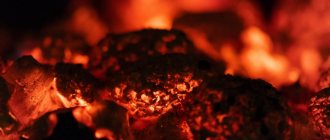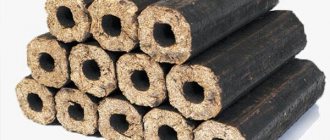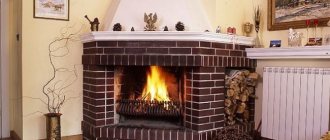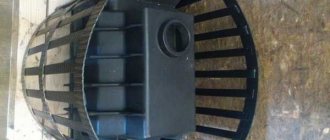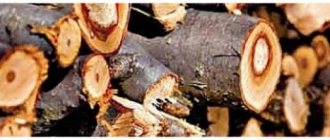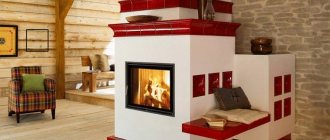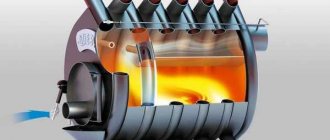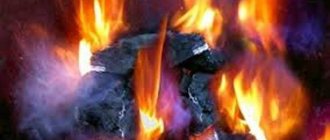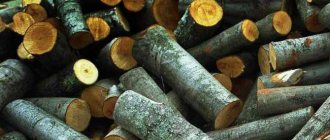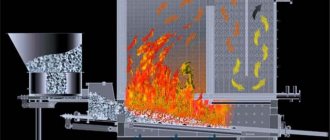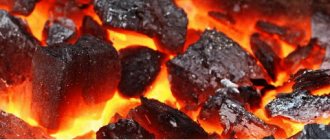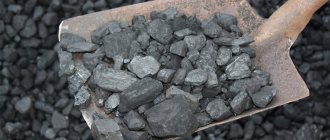What stoves can be heated with coal?
Potbelly stoves are most suitable for using coal. You can store both firewood and coal in them. After all, the material from which they are made is heat-resistant; it can withstand high temperatures for a long time.
Coal is an excellent option for a potbelly stove
Experts do not recommend using coal to heat a Russian stove. After all, its design was originally developed for wood fuel. This is due to the fact that the combustion temperature of coal in a furnace is much higher than that of firewood or other types.
A Dutch oven is also not suitable. After using fuel in such a stove, its condition deteriorates significantly: deformation of the body and parts from high temperatures, accumulation of soot in the chimney.
Heating a brick stove with coal is possible in two cases : if its firebox is lined with fireclay bricks, or if it consists of a steel frame with a wall thickness of at least half a centimeter.
Fireclay brick is resistant to high thermometer values; it can easily withstand the main temperature, while masonry made from ordinary bricks will be affected by less strong indicators. And thick steel will not deform and will easily withstand burning.
The grate in brick kilns fired with this type of fuel should be located two rows lower than usual. Coal fuel also requires an additional exhaust system.
If you equip an ordinary wood-burning brick stove correctly, then you can easily use coal to heat it.
Precautions and protection
As mentioned earlier, not all stoves, fireplaces and boiler equipment can be safely and properly heated with coal, since combustion produces a large amount of smoke, soot, and soot, and the combustion temperature can reach about 2000 degrees Celsius.
If you are going to heat a standard brick oven with coal, it is important to remember that its walls should be thick, and the grate is initially laid 2-3 rows below the area laid out in order.
The chimney or the so-called hood, in this case, is also made separately, from certain materials, using the necessary fittings, all this will ensure the necessary level of operation of the traction mechanism.
If you are not sure that the stove will withstand such high temperatures and the wall masonry is thick enough, as a precaution, many stove makers recommend placing a boiler with water directly in the hearth. Due to this, less smoke will be emitted, the fire temperature will be slightly lower, and the walls of the unit will be promptly cooled to a safe temperature.
For safety reasons, it is necessary that your stove initially has a high-quality grate and ash chamber that is suitable in size. In order for you to always have the opportunity to quickly adjust the heating temperature in the chamber and the intensity of the flame, first equip your stove with such essential attributes as:
- Deflector;
- Windcocks;
- Truboventy.
If, when using a stove to light your stove, you experience smoke of varying degrees, pay attention to:
- Smoke channel and riser. These are the places where blockages most often occur;
- Masonry. Violation of the tightness and the appearance of cracks can cause both a deterioration in the draft of the stove and the entry of a certain amount of smoke into the premises;
- Device array. It can also be resolved, which will cause this malfunction;
- Housing pipe. At the moment when the pipe begins to cool, a large amount of condensate forms;
- Two hearths. If you have two fireplaces, stoves or boilers in your house connected to one chimney, as a result of inadequate draft and other features, smoke may begin to flow in and out not into the street, but into the room.
What kind of coal is suitable?
There are different types of fuel. Let's look at them in more detail:
- Lignite. The youngest species, characterized by high friability. It has a fibrous structure. A common fuel in power plants and factories. It is used infrequently for heating homes, as it does not heat a conventional stove properly.
- Brown. This fuel consists of peat and carbon. It has a low combustion temperature due to the large amount of water and other impurities. Can be used as local fuel.
- Coal . It has a high combustion temperature due to the large amount of carbon in the composition. Has a high heat of combustion.
- Anthracite. Contains up to 95 percent carbon. It has the highest degree of combustion heat. One disadvantage is poor ignition.
For heating stoves in households, coal and anthracite are usually used, as they have greater heat transfer. This type of coal for heating a home will be required several times less than brown coal or firewood. The only drawback is poor ignition.
This problem can be solved with the help of firewood: first put logs in the firebox, and after they burn out, add anthracite.
Long-flame coal has the best price-quality ratio. It ignites quickly, has high heat transfer, and is unpretentious in storage and use.
Types of coal
Such fuel is a rock consisting of a carbon compound and non-combustible components that, when burned, form ash. In different regions there are deposits with different amounts of impurities.
Depending on the level of specific heat of combustion, humidity and age of impurities, the following types of fuel are distinguished:
Lignite
A young type of coal with a specific calorific value of no more than 2.8 thousand kcal/kg. The raw material has a loose structure and a high percentage of ash formation. Lignite ensures the operation of industrial facilities - plants, factories, power plants, but is poorly suited for domestic use as fuel.
Brown coal
Product of the transition phase between black lignite and coal. During the combustion process, it forms a large volume of ash and coking derivatives. The calorific value of the fuel is 5 thousand kcal/kg. With an average humidity of 50%, the raw material is used for industrial boiler houses and chemical production plants. Due to the rapid clogging of the chimney system and heat exchanger, it is not recommended to burn household stoves and boilers with brown coal.
Coal
High-quality fuel with a calorific value in the range from 5 to 5.7 thousand kcal/kg. It is an intermediate link between brown coal and anthracite. It contains about 70% carbon and only 3% ash. Due to low humidity (20%), the raw material is not used for gas generating units, but is suitable for most models of household boilers and stoves.
Hard coal is divided into two groups:
- Long flame. The fuel is suitable for most domestic heating installations, provides a high flame and long-lasting combustion, and does not require additional blowing. You can use a small amount of wood or wood chips to light it.
- Low caking. The raw materials are suitable for heating a private home, bathhouse or industrial facilities. It is characterized by high thermal conductivity and lack of caking. The combustion process takes place without flame or smoke.
Anthracite
The best type of fuel raw material with a dense structure and rich black color with a calorific value from 7.1 to 9 thousand kcal/kg. At a relatively low level of humidity (7%), anthracite forms a small amount of ash, which is removed from the heating equipment along with gases. It comes in different sizes: small as a seed, medium as a pea, and large as a fist.
As a result of the release of a large amount of heat, heating of rooms with anthracite occurs quickly and efficiently.
Preparing the stove for lighting
Firing a stove with coal requires preliminary preparation of the heating device itself.
Before the start of the heating season, take a number of actions:
- Inspect the oven carefully. If defects are identified in the housing, repairs must be made: seal the cracks with mortar, replace parts, if necessary.
- Clean the chimney of soot. Large accumulations of combustion waste can cause improper air circulation or even fire in the structure.
- Check all doors, dampers, and latches.
If you have verified that there are no defects and that the heating structure is in good condition, you can proceed to the next step.
Preparatory stage of lighting the stove
If you are planning to light a stove that has not been used for a long time, you should carry out a number of preparatory measures. This procedure must be carried out in order to ensure trouble-free operation of the stove, as well as to avoid unpleasant situations that sometimes lead to fires or harm to human health and life.
• Inspect for cracks. Their presence can facilitate the penetration of smoke and even carbon monoxide into the room. If any are found, minor repairs should be immediately carried out using a mixture of clay and sand. • Clean soot from all flues and chimneys. Wipe off dust from the internal walls with a dry rag so as not to smell a bad aroma when kindling. In general, it is advisable to perform this procedure 2-3 times a month. • Pay attention to the doors, especially their fit and the functionality of the locking mechanisms, to avoid the appearance of smoke. • Select fuel of the appropriate quality, suitable specifically for your type of stove. • Properly equip solid fuel storage areas.
During further operation, you should also follow a number of simple rules. Using plastic, construction and household waste for kindling will lead to severe contamination of the stove. It is incorrect to open the vent and the oven door at the same time. It should be heated several times a day for one and a half to two hours to avoid overheating. Dry, medium-sized, dust-free charcoal will provide excellent functionality.
It is strictly prohibited to use flammable mixtures (gasoline, kerosene, etc.) for kindling.
Avoid storing flammable objects near hot walls. Do not leave the stove unattended while lighting, especially in homes with children.
Coal laying
How to heat a stove with coal correctly? Correct use of this type of fuel requires its special storage. Stones are poured into the firebox only after it is fully heated with the help of firewood.
First, paper, thin wood chips, sawdust or other flammable material are placed on the grate. The logs are not stacked very tightly on top, creating air gaps for better combustion.
Coal laying
Recommendations and process of igniting the furnace firebox
The coal stove is fired a couple of times a day. The duration of combustion of raw materials in the furnace should not be more than two hours. It is recommended to load dry medium-fraction coal.
In order to heat the premises efficiently and safely using coal, you must properly light the stove. This should be done in stages:
- Initially, dry sheets of paper are placed at the bottom of the combustion chamber, on which small wood chips are laid out on top.
- Well-dried firewood is placed on top of the chopped pieces of wood. It is good to use birch logs for ignition.
- After placing all the necessary materials for kindling, the paper is set on fire. Immediately after this, you should open the blower and close the firebox door. The rate at which wood ignites depends on the presence of air masses. It is recommended to ignite with the ash pan open, as this creates a natural air flow that will allow the chimney pipe to warm up.
- When the logs burn out and ash remains in their place, you can add fuel for the first time. For this purpose, fine coal is used, which easily ignites from hot wood residues. The laying layer should be fifteen centimeters.
- If the draft increases during combustion, the ash compartment must be closed and the fan activated.
Each new portion of coal is added to the firebox only after the previous load has completely ignited. Do not allow fuel to quickly burn down to the grates. To ensure even burning of the coal, you need to turn it over several times with a poker. This action is performed when the raw material is half burned out.
When heating a stove, do not light coal with kerosene, gasoline or other flammable liquid mixture. It is also not allowed to use household waste. While lighting the stove, you should constantly monitor the combustion process of the fuel. It is not allowed to leave the vent and the door open at once. When burning raw materials, the combustion chamber must be closed.
Ignition
After burning a batch of logs and pouring coal into the firebox, you need to monitor its ignition. If a small amount of coal fuel has already burned out, you can safely add the next one.
Adding additional coal
You just need to make sure that there are air gaps between the stones. They can be made with a poker. By opening and closing the blower we regulate the combustion process.
How to melt correctly?
A coal stove or boiler is heated in the following sequence:
- open the firebox door and close the ash pan;
- Place paper on the grate and wood chips, cake or other flammable material on it. A small amount of firewood is then placed in the form of a hut or well. Set the paper on fire;
- close the firebox door and open the ash pan. In the future, each time before opening the firebox door, the vent is closed, and after closing the door, it is opened;
- after the wood filling is burned, a thin layer of fine-grained coal is placed on it;
- After the coal burns, it is stirred with a poker to prevent caking. Otherwise, air will stop flowing into the firebox;
- The main fuel is placed on the burned-out fine coal - coarse coal with a layer thickness of up to 60 cm;
- The ash flap is opened slightly so that the optimal combustion mode is established in the firebox.
When lighting a boiler with forced air supply, instead of opening the damper, turn on the fan controller and set it to the desired coolant temperature.
Features of kindling in winter
How to properly heat a coal stove in winter? In winter, cold air creates a special draft. It prevents smoke from escaping into the street.
- To ignite the stove in severe frost, you can use improvised means.
- If you have a hair dryer, take it.
- Close the ash pan door, open the firebox and valve.
- Preheat the oven for a few minutes and proceed with normal operations.
- After heating, smoke will not go into the room, and the fuel will ignite.
Firebox of sauna stoves
The differences in the operation of wood-burning sauna stoves are that they are heated periodically and at maximum settings. Both metal and brick long-burning stoves must operate exclusively on wood; no coals are allowed. Ignition and heating are carried out in the same way as in the case of heating stoves. Then large logs are placed in the firebox in order to efficiently heat the steam room for an hour to an hour and a half.
When the steam room is heated, during bathing procedures it is customary to place small logs, which will quickly light up and immediately provide warmth; there is no point in putting large firewood. You need to be careful here, as an ember can shoot out of the open opening and cause burns to you.
More information about installation and operation errors of a sauna stove is described in the video:
Firebox rules and coal combustion temperature in the furnace
Basic Rules:
- Coal is added as it burns. Its thickness should not exceed 60 mm.
- When opening the firebox door, the vent should be closed.
- If the stove is equipped with a hob, the vent should be covered at any load. If this is not done, smoke will enter the room.
- The fuel should burn evenly.
- If you have a large amount of coal dust left over during coal storage, you can use it. How to properly heat a stove with coal dust? Wait until the bulk of the fuel burns, and then add a small amount of dust.
- When the combustion ends, you need to cover the vent.
- The chimney closes only when the coals have completely burned out.
It is not recommended to immediately heat the oven too much. It is better to do this gradually, so that a comfortable temperature will be maintained in the room for a long time. You should pay attention to the moisture content of the coal.
If the fuel has an excess of moisture, then less heat will be released during the heating process. This is due to the fact that drying requires significant energy expenditure.
The combustion temperature of coal in a conventional furnace can reach thousands of degrees. But usually it is much less - 600-800 degrees. The combustion temperature of anthracite at home is 500-600C, and the highest reaches 2100C.
Types of coal or what to throw in the firebox
Before making a final decision on the type of fuel with which you are going to heat your home, it would be useful to find out some details about each of them, especially if you have never faced such a task before. After all, the properties of coal and wood are different, and, unknowingly, you can get into an unpleasant situation by spending money on equipment that ultimately will not suit you.
So, what is more profitable and convenient for heating? Let's figure it out.
With coal, not everything is as simple as it seems at first glance. Our country has a coal classification adopted back in 1988. According to it, only a few types of coal are suitable for heating a private home.
Hard coal is divided into the following categories:
- Long flame coal (D). Such coal burns for a long time, releasing a large amount of heat (5600-5800 kcal/kg). Long-flame coal ignites easily and does not require additional airflow, natural draft is sufficient. Therefore, such coal is most often recommended for heating in homes. The price also speaks in its favor - it is cheap enough that it is even purchased for heating municipal institutions.
- Long-flame gas (LG). It generates more heat than long-flame coal, however, it is demanding on storage conditions - it is more susceptible to weathering.
- It happens that lean coals (T), low-caking coals (SS) and fatty coals (F) are used for heating.
These are the most common types of coal for heating homes. In addition to them, brown coals (B) and anthracites (A) are used.
Anthracite, perhaps, has the best properties: it emits the maximum amount of heat, burns evenly and for a long time, produces white smoke when burning (other types emit black smoke), has a low ash content (about 10%), and also the lowest sulfur content (1%) . But anthracite is not recommended for private homes due to its high cost and problems with ignition.
Industrial types of coal - coking and enriched - cannot be used in a home boiler; they emit a huge amount of heat, which household equipment is simply not designed for. Such coals are used in industry for metal smelting and other energy-intensive processes.
In addition, you need to know about the storage conditions of different types of coal, because the quality of coal depends even on the deposit where it was mined. Coals from different deposits have different resistance to oxidation. According to this characteristic, coals are divided into four categories:
- The most stable - the shelf life of large fractions is up to 36 months, small fractions - up to 24 months
- Stable - stored for about 18 months
- Medium stability - shelf life 12 months
- Unstable - stored for 6 months
However, in order for the purchased coal to retain its properties according to the category, certain measures must be taken. The coal supply should be stored in a dry place, avoiding getting wet; it is better to prevent excessive oxidation by simply covering the coal with a dense material, such as a tarpaulin. Also, high temperatures and direct sunlight are not recommended for coal.
It is important to remember that oxidation, and with it the loss of quality, begins at 20-25 degrees, up to 40 degrees this process is slow. It is also called weathering - cracks appear, pieces of coal become brittle
But if the storage temperature does not decrease, this can lead to dire consequences, since coal spontaneously ignites at high temperatures.
In addition to types, coals are also divided into sizes, which is important to consider when buying a boiler. The following fractions are accepted in the domestic classification:
- Slab (more than 100 mm)
- Large (50-100 mm)
- Walnut (26-50 mm)
- Small (13-25 mm)
- Seed (6-13 mm)
- Piece (no more than 6 mm)
- Private (size not specified)
The coal fraction is important because many modern boilers, especially those equipped with an automatic loading system, are designed for a certain diameter of pieces.
In fact, when choosing a boiler for heating your home with coal, you should first ask what types of coal and what fraction are easiest to buy in your region. Thus, from the heating systems on the market, it will be easy for you to choose the one that will be more economical and convenient to use for you.
The boiler passport must indicate not only the types and fractions of suitable coal, but also the algorithm for ignition and maintenance of combustion.
Conclusion
Coal is the most common type of fuel. Its heat transfer is significantly higher than that of firewood, briquettes and pellets. Not all types of stoves can be heated with this product. To use it, you need a special firebox made of fireclay bricks or dense steel.
The process of laying, igniting and burning a corner will not require much effort if you follow the basic rules. But it will not be possible to heat the room with this type of fuel alone, since additional materials are required for ignition: paper, wood chips, small logs.
Types of coal
Coal is of plant origin. For the most part, this fossil consists of carbon and non-combustible components, which turn into ash during combustion. Coal mined in different regions contains different amounts of such impurities. When ignited, the sulfur in the rock forms oxides that form sulfuric acid in the atmosphere. The largest proportion of sulfur comes from lignite. Based on its characteristics, coal comes in several types.
Coal is classified by age as follows:
- Lignite (youngest);
- brown (subbitominous) coal;
- coal;
- anthracite (the oldest deposits).
According to the content (B) of moisture and volatile impurities (MP):
- brown (subbitominous) coal: B=30-40%, LP > 50%;
- hard coal: B=12-16%, LP=40%;
- anthracite: B=5-7%, LP=5-7%.
Specific heat of combustion:
- brown coal – 3000-5000 kcal/kg;
- hard coal – 5000-5500 kcal/kg;
- anthracite – 7400-9000 kcal/kg.
Design features of coal furnaces
If you look closely at a coal stove and its most common wood-burning competitor, then, in principle, it will be difficult to find any special differences at first glance. But upon closer examination and familiarization with the operating principle of the furnace itself, it becomes clear that they differ fundamentally. (See also: Do-it-yourself housekeeper oven)
- The principle of combustion and air supply differs; if for wood-burning stoves the most efficient combustion can be achieved when air is supplied directly to the place of fuel combustion from above, then for coal stoves it is necessary to purify the fuel and supply the air mixture from below.
For wood-burning stoves, the use of dry fuel during the combustion process is not particularly critical. It is only important that the initial lighting of the stove occurs with dry material. Before adding coal to the furnace, it is advisable to preheat it in a special compartment of the furnace, which is heated by exhaust gases.
The design of the chimney for a coal-fired stove is somewhat different from its wood-burning counterparts and is designed for a higher air flow rate. And the flow itself and its speed are regulated not by a blower, but by a blower. The damper itself, blocking the chimney (yushka), is completely absent. This feature is due to the fact that coal stoves smolder for a very long time, and do not quickly burn through fuel like wood stoves. The disadvantages of coal stoves are also associated with this feature:
- It is impossible to block the chimney to prevent the weathering of heat due to the danger of carbon monoxide poisoning, and therefore coal heating stoves cool down quite quickly.
- For normal combustion of a coal furnace, it is advisable to exclude the presence of combustion products in its lower compartment. To do this, it is necessary to periodically clean the ashpit, which will be constantly replenished with burnt coal. In this case, cleaning must occur more often than is necessary for a wood stove.
The walls of coal stoves must withstand higher temperatures than conventional wood stoves; accordingly, they will be thicker, and more heat-resistant materials must be used for their assembly.
(See also: DIY camp stove)
A coal stove may have a special design for loading fuel, this is due to the higher ignition temperature of coal - that is, it will not be possible to light such a stove with just a piece of newspaper and matches. Therefore, in a coal stove, firewood is first lit, and coal is loaded on top, which gradually flares up as the wood burns out.
In practice, combination stoves are often used, in which both coal and wood can be burned simultaneously. In addition, peat briquettes, which burn very much like coal, can also be used as fuel. In combined devices, all elements of both a coal and wood stove are simultaneously present.
